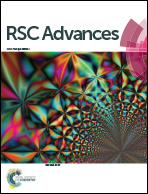Self-assembly of miscible homopolymer/quasi-block copolymer blends/MWNT composites: a strategy to obtain ultralow electrical percolation threshold and mechanism†
Abstract
Herein we developed a strategy to lower the electrical percolation threshold by the self-assembly of miscible polymer blends of homopolymer/quasi-block copolymer blends/CNT composites. Orderly formation of CNT networks and p–π interaction was observed. Further explorations of the variations of miscibility and segmental motion are required.


 Please wait while we load your content...
Please wait while we load your content...